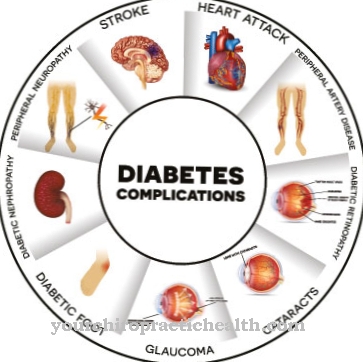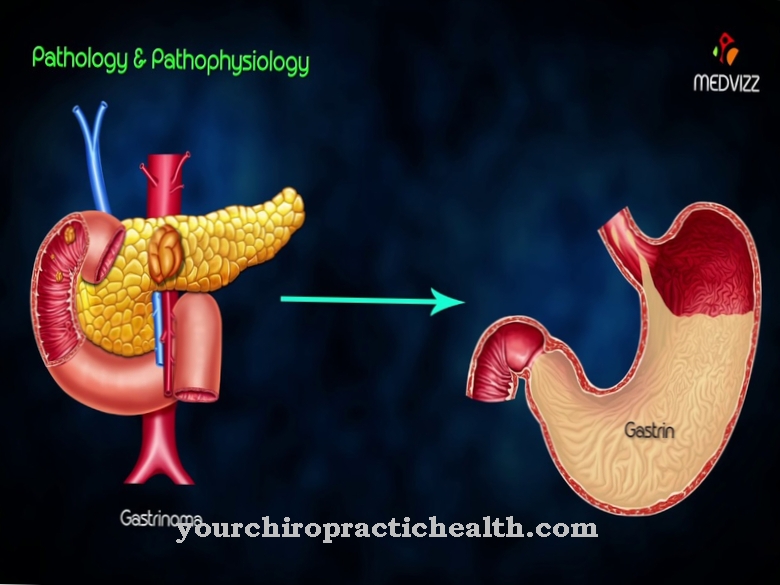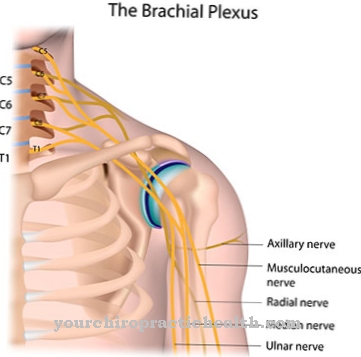The Cerebral hemorrhage is a generic term for the so-called intracranial hemorrhage (cerebral hemorrhage inside the cerebral skull), the intracerebral hemorrhage (cerebral hemorrhage in the area of the brain) and the extracerebral hemorrhage (cerebral hemorrhage of the meninges). In the narrower sense, however, is usually the intracerebral cerebral hemorrhage That means directly in the brain.
What is a cerebral hemorrhage?

The Cerebral hemorrhage is an umbrella term for three different types of bleeding that can occur in the skull and brain. A distinction is made between intracranial cerebral hemorrhage, intracerebral cerebral hemorrhage and extracerebral cerebral hemorrhage.
In intracerebral cerebral hemorrhage, the hemorrhage is located in the brain. Usually this occurs spontaneously and is not caused by a trauma (accident).This causes bleeding into the parenchyma (brain tissue). The bleeding is classified according to cause, severity and location in the brain tissue.
The intracranial cerebral hemorrhage is also known as epidural hemorrhage. This comes in two forms, the arterial epidural hematoma and the venous fracture hematoma. The arterial epidural hematoma occurs as a result of a traumatic brain injury in which the arterial vessels lying on the inside of the skull bone tear. In venous fracture hematomas, the blood seeps through the hernia of a skull fracture into the so-called epidural space and collects there.
With extracerebral cerebral hemorrhage, a distinction is made between subdural hemorrhage and subarachnoid hemorrhage. The subdural hemorrhage - also known as a subdural hematoma - is a bruise under the meninges that can occur as a result of skull injuries. The subarachnoid hemorrhage takes place under the arachnoid (spider web skin). In this type of cerebral haemorrhage, in contrast to the other bleeding, liquor (cerebral fluid) can be detected.
causes
The causes of a Cerebral hemorrhage can be very diverse. Usually, cerebral hemorrhage occurs as a result of trauma such as B. traffic accident, fall, etc. on.
Diseases can also be the cause of cerebral hemorrhage. In particular, high blood pressure (hypertension), vasculitis (inflammation of the blood vessels), aneurysm, amyloid angiopathy (disease of the blood vessels in the brain) and coagulation disorders are possible.
Cerebral hemorrhage can also have a genetic cause. Vascular malformations - malformations of the blood vessels - are congenital. Brain tumors, as well as vascular tumors, can cause cerebral haemorrhage.
The use of certain medications can also trigger bleeding in the brain. The drug group of anticoagulants should be mentioned in particular. Well-known drugs in this group are heparin and phenprocoumon.
Long-term alcohol and / or drug consumption can lead to cerebral hemorrhage. If there is no cause for a cerebral haemorrhage, one speaks of a so-called spontaneous cerebral haemorrhage.
Symptoms, ailments & signs
Depending on which brain area is affected by the cerebral hemorrhage, different symptoms can occur. A cerebral haemorrhage usually manifests itself as a sudden, very severe headache. These are accompanied by nausea and vomiting as well as impaired consciousness. Depending on the type and severity of the bleeding, the neck may stiffen, combined with neurological deficits.
In the course of the cerebral hemorrhage, an increasing feeling of dizziness occurs, which in turn manifests itself in balance and coordination problems and is associated with an increased risk of accidents and falls. Visual disturbances such as double vision, blurred vision or temporary loss of vision in one or both eyes are also typical. In addition, speech disorders, speech disorders and swallowing disorders can occur, always depending on which brain area is affected and how bad the cerebral hemorrhage is.
Furthermore, a cerebral hemorrhage can cause psychological complaints, for example confusion, inexplicable changes in behavior or changes in feelings. In the case of large bleeding, consciousness is clouded after a few minutes. In the further course, a cerebral hemorrhage causes seizures, numbness and finally a circulatory collapse. If the person concerned is not treated in intensive care by then at the latest, there is an acute risk of death. If the treatment is too late, complications can arise and there may be long-term effects.
Diagnosis & course
The diagnosis is made Cerebral hemorrhage by means of imaging procedures. CT, X-ray and MRI are used. In first aid, a CT is usually done, as this can be done faster than an MRI. Here, the location and the size of the cerebral hemorrhage are determined. Another CT scan at a later point in time will monitor the increase in size of the cerebral hemorrhage.
Since the time factor plays a very important role in a cerebral haemorrhage and the general condition of the person concerned is usually very limited, magnetic resonance imaging (MRI) is only performed when the patient has been stabilized. With the help of MRI, older bleeding can also be visualized using a contrast agent. In addition, this method can also be used to make the vessels visible so that an aneurysm or other malformations can be identified.
The course of a cerebral hemorrhage depends on many factors. These factors are the age and general condition of the person concerned, current constitution, underlying diseases, the location of the cerebral haemorrhage as well as its size and expansion rate.
The death rate for minor bleeding is around 30 to 50%. In the case of extensive cerebral hemorrhage and negative health factors (see above), the prognosis can be described as poor. If those affected survive the cerebral haemorrhage and any subsequent bleeding that may occur, permanent damage such as paralysis, speech disorders and other mental and physical disabilities are the result.
Complications
A cerebral hemorrhage is already a serious complication from another cause. If there is a cerebral haemorrhage, severe impairment of consciousness and neurological failures usually follow. Those affected usually experience impaired attention, learning and memory, disorientation and disturbances in the sequences of movements and actions. Depending on the extent of the cerebral haemorrhage, epileptic seizures, regulatory disorders (for example, body temperature) and spasticity can also occur.
Visual field deficits, perception disorders and swallowing disorders can also occur as a result of cerebral haemorrhage and cause further complications. In the further course of the disease, the cardiovascular system becomes paralyzed and the person affected can either be coma or die. Depending on the type and extent of the cerebral hemorrhage, treatment can be associated with a variety of other complications. The affected person may have to be put into an artificial coma, which is often associated with permanent consequential damage.
Long-term ventilation in a coma can also lead to pneumonia and nerve damage in the arms and legs. In addition, negative side effects such as muscle wasting and impaired nerve water circulation are possible, which can sometimes cause further nerve and brain damage. After awakening, an acute state of confusion (delirium) may remain.
When should you go to the doctor?
The cerebral haemorrhage represents a medical emergency. As soon as the patient suffers a head injury and shows noticeable symptoms such as memory loss or vomiting, an emergency doctor must be called. Until the arrival of the rescue service, keep calm and apply first aid measures. Consult a doctor if you have a headache, fainting or impaired consciousness. If you experience dizziness, unsteadiness or circulatory problems, there is cause for concern.
A doctor should be consulted if symptoms occur for no apparent reason or if there is a brief overload. In the case of amnesia, memory lapses or a diffuse memory, a medical examination must be initiated as soon as possible. Behavioral problems, changes in personality or language disorders are warnings that should be taken seriously. If there are coordination problems, impaired vision or sensitivity disorders, the person concerned needs help.
Symptoms such as pupils of different sizes or general weakness on one half of the body or rising blood pressure are particularly noticeable. A medical examination is urgently required if these symptoms occur. Since a cerebral haemorrhage can in the worst case lead to the premature death of the person affected, fast and good medical care is necessary. If the first abnormalities occur suddenly, a doctor or hospital visit should be made immediately. If you notice an increasing feeling of pressure inside the head, you must hurry and contact a doctor.
Doctors & therapists in your area
Treatment & Therapy
When treating a Cerebral hemorrhage the time factor is decisive. The longer it takes to care for the person, the more likely it is that they will not survive the cerebral hemorrhage. If there is a suspicion of a cerebral haemorrhage, go to the nearest hospital immediately or call the emergency doctor.
The treatment of cerebral haemorrhage is divided into acute treatment and long-term treatment. Depending on the cause, acute treatment can be as follows. Since the brain functions are restricted by the cerebral hemorrhage, the affected person usually has to be artificially ventilated. If there is an increase in pressure due to the cerebral hemorrhage, an operation is carried out. This involves opening part of the skull bone in the affected area. The bruise is then removed. The bleeding is also stopped.
Is z. If, for example, a coagulation disorder is the cause, blood is administered to normalize blood clotting. Fresh plasma concentrates in particular are used here.
If the cause is too high blood pressure, various drugs are used to lower the blood pressure. If the bleeding is extensive, it may be necessary to have the bruise removed by surgery. With a subarachnoid hemorrhage there is a risk of so-called hydrocephalus (cerebral congestion), which must also be treated by means of neurosurgical intervention.
Long-term treatment begins when the person concerned has survived the critical phase. This treatment usually involves lengthy, neurological rehabilitation. Various measures are used to try to eliminate the neurological and physical dysfunctions. Depending on how severe the cerebral hemorrhage was and how quickly the treatment was carried out, it may take several years before the person affected can take care of himself again. In many cases, however, residual symptoms remain with a cerebral hemorrhage.
Outlook & forecast
Cerebral haemorrhage is a serious disease, the prognosis of which is linked to various factors. First of all, this is the severity of the appearance. In this context, it is not only the extent of the cerebral hemorrhage that is relevant for the outlook, but also whether it is a single bleeding area in the brain or several. For this it is important in which area of the brain the cerebral hemorrhage occurred. When important areas in the brain are affected, functional disorders such as paralysis, language disorders or other symptoms are often difficult to reverse.
It is important that cerebral hemorrhage is treated competently at an early stage. The time between the onset of the cerebral hemorrhage and the start of treatment therefore also plays a major role. Because the longer the start of treatment is delayed, the more time the cerebral hemorrhage has to spread. This may mean irreversible damage to the patient.
For the prognosis of the patient, it is also important what his general condition is and whether there are relevant previous or accompanying illnesses. The cerebral hemorrhage often puts the patient in a critical condition, which the better the general condition, the easier it is to survive. An increased tendency to bleed or patients who are dependent on Marcumar or other drugs for blood thinning are factors that, in turn, can significantly worsen the prognosis for cerebral hemorrhage.
prevention
One Cerebral hemorrhage can be prevented with the following measures. So that there is no cerebral hemorrhage as a result of trauma, the generally known measures for accident prevention in the field of work, sport, everyday life and traffic should always be followed.
In order to reduce the risk of other cerebral hemorrhages, care should be taken to exercise and avoid being overweight. In particular, being overweight and not being physically active lead to high blood pressure. Furthermore, regular health checks should be carried out if there is a familial accumulation of cerebral haemorrhage, stroke, heart attack, high blood pressure, blood clotting disorders, etc.
If there is high blood pressure, diabetes or other illnesses, these should be treated with medication and monitored by a doctor. A healthy and balanced diet, sufficient exercise and the general preventive medical check-ups are good measures to prevent cerebral hemorrhage.
Aftercare
Patients who have survived a cerebral haemorrhage need follow-up care. Their intensity depends on the extent, age and level of consciousness of the person concerned. It is not uncommon for protracted therapy to be necessary to remedy functional disorders. Often neurological and physical processes have to be relearned. Doctors prescribe prescriptions and document the progress of the treatment.
The experience of the patient plays a major role in the therapeutic approaches. In addition, imaging methods such as CT and MRT are used. Not all patients make full recovery. Older people in particular have a low regeneration potential. Follow-up care then aims to keep complications as low as possible or to show alternatives.
What remains, for example, are disorders in concentration and motor skills. Changes in personality are also occasionally encountered. As far as possible, medication can bring about an improvement. The attending physician regularly adjusts the dose. Cerebral haemorrhage can recur. That is why it is important to rule out causes.
Elevated blood pressure is considered a risk factor. Many doctors therefore prescribe drugs to lower blood pressure. But the patient himself is also responsible for preventive measures. A moderate consumption of alcohol, abstinence from nicotine, daily exercise and a balanced diet reduce the risk of illness.
You can do that yourself
Sudden cerebral hemorrhage is an acute emergency. In the case of certain symptoms such as paralysis on one side, speech disorders, dizziness, the person affected must be treated professionally as quickly as possible. These warning signs should be taken seriously and the emergency number 112 should be dialed immediately.
Risk factors that can lead to a hemorrhage in the brain can be prevented. One of the most common causes of cerebral hemorrhage is high blood pressure. To prevent high blood pressure, some measures should be observed. It is important for high blood pressure patients to take their own blood pressure measurements on a daily basis, to visit the doctor regularly and to take the prescribed medication consistently. This can reduce the risk of rebleeding or rebleeding.
A regular health check is urgently recommended in the case of family history such as stroke, heart attack, high blood pressure, impaired blood clotting and other metabolic diseases. Excessive consumption of alcohol and regular tobacco smoking pose a health risk. It has been proven that there is a two to three times higher risk. If possible, those affected should refrain from excessive alcohol consumption and stop smoking.
Preventive measures should not be started in old age. If you pay attention to your lifestyle early on, you can prevent a stroke. A balanced, vitamin-rich, low-fat, high-fiber diet (fresh fruit and vegetables) and exercise support weight loss, among other things (even a few pounds less body weight can prevent many health problems). Relaxation exercises such as yoga or autogenic training contribute significantly to maintaining health.


.jpg)

























.jpg)